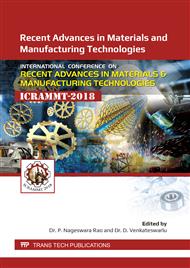[1]
DuPont J.N., Lippold J.C. and Kiser S.D.: Welding metallurgy and weldability of nickel-base alloys, A John Wiley & Sons, Inc., Publication, Hoboken, New Jersey (2009).
DOI: 10.1002/9780470500262
Google Scholar
[2]
Siefert J A and David S A, Weldability and performance of candidate austenitic alloy for advanced ultra-supercritical fossil power plants, Science and Technology of Welding and Joining, 19 (2014) 271-294.
DOI: 10.1179/1362171814y.0000000197
Google Scholar
[3]
David S A, Siefert J A, DuPont J N and Shingledecker J P, Weldability and weld performance of candidate nickel base superalloys for advanced ultra-supercritical fossil power plants part I: Fundamentals, Science and Technology of Welding and Joining, 20 (2015) 532-552.
DOI: 10.1179/1362171815y.0000000035
Google Scholar
[4]
Lingenfelter A C, Varestraint testing of nickel alloys, Welding Journal, Vol 9 (1972) p 430s -436s.
Google Scholar
[5]
PD CEN ISO/TR 17641-3:2005, Destructive tests on welds in metallic materials, Hot cracking tests for weldments Arc welding processes, Part 3: Externally loaded tests. BSI, May (2004).
DOI: 10.3403/03263851u
Google Scholar
[6]
Joel Andersson, Jonny Jacobsson, Anssi Brederholm and Hannu Hänninen, Improved Understanding of Varestraint Testing—Nickel-Based Superalloys, Cracking Phenomena in Welds IV, edited by Thomas Böllinghaus, John Lippold, Carl E Cross, (2016) 25-36.
DOI: 10.1007/978-3-319-28434-7_2
Google Scholar
[7]
Lippold J C, Recent Developments in Weldability Testing for Advanced Materials, Joining of Advanced and Specialty Materials VII, conf proc Materials Solutions 2004 on Joining of Advanced and Specialty Materials, (eds) Lienert T J, Weil K S, Zhou Y N, Smith R W, and Powers M Ohio (2004) p.1.
Google Scholar
[8]
Lippold J.C., Baeslack W.A.I. and Varol I.: Heat-affected zone liquation cracking in austenitic and duplex stainless steels, Welding Journal, vol 71 (1992) p.1-s.
DOI: 10.4028/www.scientific.net/kem.69-70.217
Google Scholar
[9]
Lundin C D, Lee C H and Qiao C Y P, Evaluation of Backfilled Solidification Cracks in Austenitic Stainless Welds in Relationship to Evaluation of Hot Cracking, Welding Research Supplement, Vol-7 (1993) p.321-S.
Google Scholar
[10]
Li Jiang, Wen-Zhu Zhang, Zhou-Feng Xu, He-Fei Huang, Xiang-Xi Ye, Bin Leng, Long Yan, Zhi-Jun Li, Xing-Tai Zhou, M2C and M6C carbide precipitation in Ni-Mo-Cr based super alloys containing silicon, Materials & Design, Vol-112, 2016, pp.300-308.
DOI: 10.1016/j.matdes.2016.09.075
Google Scholar
[11]
Wenjie Ren, Fenggui Lu, Renjie Yang, Xia Liu, Zhuguo Li, Liquation cracking in fiber laser welded joints of inconel 617, Journal of Materials Processing Technology, vol 226, 2015, pp.214-220.
DOI: 10.1016/j.jmatprotec.2015.07.004
Google Scholar


